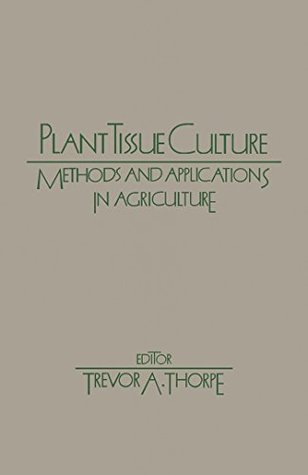Full Download Plant Tissue Culture: Methods and Application in Agriculture - Various | PDF
Related searches:
Plant Tissue Culture: Current Status and Opportunities IntechOpen
Plant Tissue Culture: Methods and Application in Agriculture
Tissue Culture and its Types - Applications, Techniques and
Plant Tissue Culture: Environmental Condition, Methods, Types and
Plant Tissue Culture - Types, Techniques, Process and its Uses
An Introduction to Plant Tissue Culture: Advances and
Plant Tissue Culture, Methods and Applications
Plant Tissue Culture Protocol - Methods and Protocols
Essay on Plant Tissue Culture: History, Methods and Application
Large-Scale Tissue Culture: Methods and Applications - Plant
Plant Tissue Culture: Techniques and Experiments - Amazon.com
Trends in the use of tissue culture, applications and future aspects
Plant Tissue Culture and DNA Delivery Methods SpringerLink
19 jan 2016 tissue culture is mainly used for 4 obtaining disease free plants. Plant in vitro technology can have three major areas, namely micro.
Plant tissue culture techniques and experiments is a manual that contains laboratory exercises about the demonstration of the methods and different plant materials used in plant tissue culture. It provides an overview on the plant cell culture techniques and plant material options in selecting the explant source.
Plant tissue culture depends on the ability of plant tissue to give rise to an entire new plant when provided with a growth medium and appropriate environment. This ability of plant cells or tissues is termed ‘totipotency. ’ the fundamental steps of plant tissue culture are fourfold: select a healthy parent plant (explant).
In plant cell culture, plant tissues and organs are grown in vitro on artificial media, under aseptic and controlled environment.
Nr plant tissue culture is the process of growing isolated plant cells or organs in an artificial nutrient media outside the parent organism. In other words, it is an in vitro culture of plant cells or tissues on an artificial nutrient media under aseptic conditions, in glass containers.
Gunitilleke and samaranayake (1988) used shoot tips for the micropropagation of hevea brasiliensis.
Environmental cues and signals (physical or chemical) are also of importance in tissue-culture-related methods.
Plant tissue culture has developed widely incorporated into biotechnology, the agricultural systems being a key factor to support many.
Background: a plant growth-promoting endophytic bacterium pvl1 isolated from the leaf of vanda cristata has the ability to colonize with roots of plants and protect.
Plant tissue cultures should be incubated under well-controlled temperature, humidity, air circulation, light quality, and for specific duration.
Introduction large-scale tissue culture, also called mass cultivation, is a process of growing the cell suspension at a volume higher than 1l (volume of shake flasks). The attempt to culture plant cells started in the 1960s, by using microbial fermenters or bioreactors.
6: plant tissue culture select a healthy parent plant (explant). Eliminate any microbial contamination from any exposed explant surfaces.
Plant research often involves growing new plants in a controlled environment. These may be plants that we have genetically altered in some way or may be plants of which we need many copies all exactly alike. These things can be accomplished through tissue culture of small tissue pieces from the plant of interest.
Types of cells grown in culture tissue culture is often a generic term that refers to both organ culture and cell culture and the terms are often used interchangeably. Cell cultures are derived from either primary tissue explants or cell suspensions.
Micropropagation is the tissue culture technique used for rapid vegetative multiplication of ornamental plants and fruit trees by using small sized explants. Because of minute size of the propagules in the culture, the propagation technique is named as mircopropagation.
Preparation of suitable nutrient medium: suitable nutrient medium as per objective of culture is prepared and transferred into suitable containers.
26 apr 2019 recent findings call for the critical overview of some incorrectly used plant cell and tissue culture terminology such as dedifferentiation, callus,.
Plant tissue culture- technique of growing plant cells, tissues, and organs in an artificially prepared nutrient medium under aseptic condition. Origin� early 20th century with the work of gottleib haberlandt (plants).
Plant tissue culture 48,977 plant tissue culture was a new addition to the methods of plant breeding that developed around the 1950s. Since the conventional breeding techniques could not fulfil the required demand of crops, tissue culture came around as a grand leap in breeding practices.
Due to the diversity of the methods and applications of available culture techniques, the subject of plant.
Plant tissue culture (ptc) is a set of techniques for the aseptic culture of cells, tissues, organs and their components under defined physical and chemical.
Definition of plant tissue culture: plant tissue culture has a great significance in plant biotechnology specially in the crop improvement programmes. The term tissue culture may be defined as the process of in-vitro culture of explants (pieces of living differentiated tissues) in nutrient medium under aseptic conditions.
Plant tissue culture refers to growing and multiplication of cells, tissues and organs of plants on defined solid or liquid media under aseptic and controlled.
Plants can produce both primary and secondary metabolites and the use of plant tissue culture methods for the production of secondary metabolites is very much common.
Plant tissue culture iterates the methods for clonal propagation, creating somaclonal variation and organ culture featuring monoploids, haploids, diploids, dihaploids, somatic embryogenesis, embryo rescue, cybrid developments, harnessing secondary metabolite production and plant transformation.
Applications of plant tissue culture today's high yielding oil palms on plantations in malaysia were generated in the 1960s by tissue culture methods. These palms produce 30% more oil than normally cultured palms.
Saintpaulia, ferns, orchids and a number of other plants lend themselves to easy home tissue culture production. While you can order a kit the best method is to attend a home tissue culture workshop where you are taught by an expierenced instructor.
This process involves the use of small pieces of a given plant tissue.

Post Your Comments: